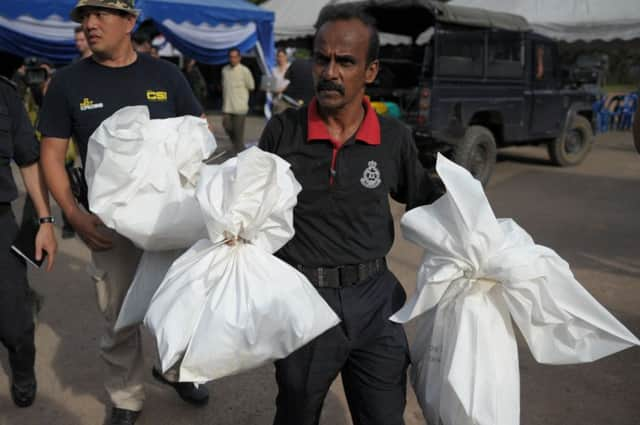139 ‘graves’ found in human traffickers’ camp


National police chief Khalid Abu Bakar said forensics experts were exhuming the suspected graves found at 28 vacated camps in the hilly jungle area on the border with Thailand where trafficking syndicates were known to operate.
“It is a very sad scene,” he said, “I am shocked. We never expected this kind of cruelty.”
Advertisement
Hide AdAdvertisement
Hide AdAt one camp, police found “a highly decomposed body” that will be examined by forensics experts, as teams began digging up the areas believed to be graves – mounds of earth, covered with leaves and marked by sticks.
“We have discovered 139 of what we believe to be graves,” Mr Khalid said. “We believe they are victims of human trafficking.”
The finding follows a similar discovery earlier this month by police in Thailand, who unearthed dozens of bodies from shallow graves on the Thai side of the border. The discoveries have exposed hidden networks of jungle camps run by human smugglers, who have for years held countless desperate people captive while extorting ransoms from their families.
Most of those who have fallen victim to the trafficking networks are members of Burma’s persecuted Rohingya Muslim community or impoverished migrants from Bangladesh, part of a wave of people who have fled their homelands for countries such as Malaysia, where they hope to find work or live freely.
As south-east Asian governments launched crackdowns in recent weeks amid international pressure and media scrutiny, traffickers abandoned camps on land and in boats to avoid arrest.
Mr Khalid said at least two of the camps found in Malaysia appeared to have been abandoned within the past few weeks, based on the condition of items left behind such as vegetables, rice and almost new cooking utensils. Scattered personal possessions included a pink teddy bear and white children’s sandals, indicating the possible presence of young people at the camp.
On three large whiteboards, police pasted dozens of pictures taken at the camps, which ranged in size, with the largest capable of holding about 300 people and smaller ones for just a few dozen. Some pictures showed large, crudely built pens made from wooden sticks, believed to have been used as cages.
“We think the migrants were imprisoned in these wooden pens,” Mr Khalid said. “They were not allowed to move freely and traffickers kept watch at sentry posts.”
Advertisement
Hide AdAdvertisement
Hide AdOther items left behind included a rifle pouch, used bullets and bullet casings.
In the past two weeks, some 3,600 people – about half Bangladeshi and half Rohingya from Burma – have landed in Indonesia, Malaysia and Thailand. Thousands more are believed to be trapped at sea in boats abandoned by their captains.